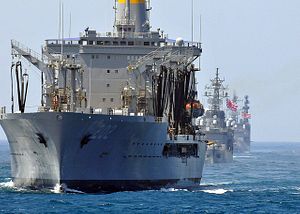Japan is beginning its full-court press in pursuit of a more normalized military posture, with several moving pieces working in tandem to achieve that goal. Prime Minister Shinzo Abe’s government’s dexterity in pushing forward several key pieces of this policy at once is indicative of its absolute hold on power in the Diet, and the lack of any concerted opposition there or among the public at large. It appears that, although the government has promised it will gain public understanding and support for its new collective self-defense interpretation, it does not expect to face any major challenges before the end of the year.
Two recent high-level meetings between U.S. and Japanese defense officials show that the Japanese government has every intention of codifying its change in military posture, albeit in stages. A new schedule to rewrite the Guidelines for Japan-U.S. Defense Cooperation was reached by U.S. Secretary of Defense Chuck Hagel and Japanese Defense Minister Itsunori Onodera last Friday. The new guidelines are to be finalized before the end of the year, with an interim report scheduled for some time in September or October, according to sources who spoke with the Yomiuri Shimbun. The government sources expect the revision of the guidelines to focus on cooperation over grey-zone issues, specifically the seizure of remote islands. As this specific grey-zone issue was one that the ruling LDP wanted included in the Cabinet’s new interpretation of collective self-defense, it appears to be seeking to further entrench U.S. support, and perhaps lower the threshold for U.S. cooperation in such cases. The current guidelines were written in 1997 when tensions on the Korean Peninsula were the biggest bilateral security concern, and they do not address grey-zone issues.
On the sidelines of this year’s RIMPAC exercises in Hawaii on Monday, the Chief of Staff of the Japanese Maritime Self-Defense Forces Katsutoshi Kawano and the U.S. Commander of the Pacific Fleet Harry Harris commented on the deepening of cooperation between the two navies, saying they had increased information sharing and personnel exchanges. Harris called the Abe Cabinet’s decision to change collective self-defense “a bold… landmark decision, and I welcome anything that would bring us even closer together.” Kawano for his part emphasized that the new interpretation still needs Diet approval before it can effectively deepen U.S.-Japanese military ties, but that if it does so, the U.S. Navy and the MSDF relationship would be positively affected.
Indeed, efforts to legislate are already underway in the Diet, as debate over an expanded SDF mandate began in both houses of the parliament this week. Abe is expected to speak during both debates, as the government is seeking to ensure that it is not perceived to be stoking tensions with China, but rather solidifying its relationship with the U.S., and putting it on a more equal footing. As the LDP and its coalition partner New Komeito together hold a majority in both houses, the legislation that emerges from these debates can be expected to largely reflect the administration’s point of view.
As a material example of the government’s holistic commitment to military reform, Defense Ministry officials have said the government is thinking about increasing the number of F-35 stealth fighters it plans to buy. After visiting a Lockheed Martin Corp. facility in Texas on Tuesday, Onodera said Japan could increase the number of jets it purchases if the procurement price drops. Japan currently plans to purchase 42 of the F-35s, which due to the fighter’s expensive development costs comes in at around 15 billion yen ($147 million) per jet. However, once production is fully underway the cost is expected to drop, at which point the ministry says it may consider buying more of the F-35s to replace its aging fleet of 100 F-15 mainstay fighters.
The Abe government is certainly pushing for the swift integration of a normalized collective self-defense interpretation on several fronts, and it’s unsurprising that the government is choosing to highlight its security relationship with the U.S. at every step of the way. A recent poll by Nippon Television showed that the Abe’s Cabinet’s approval rating was at its lowest level since coming to power, at 45.2 percent. Without having yet provided the public with the clear explanation for collective self-defense that the government promised, it is seeking to portray the new interpretation as a necessity for maintaining a strong security relationship with the U.S., especially by highlighting U.S. assistance in grey-zone situations. However, the administration has made clear that, for the time being, it is not overly concerned with opposition to its new policy and is proceeding on all fronts to solidify its gains. Without a concerted political opposition or substantial public disapproval, it appears that for right now Abe’s normalization policy is enjoying de facto support.

































